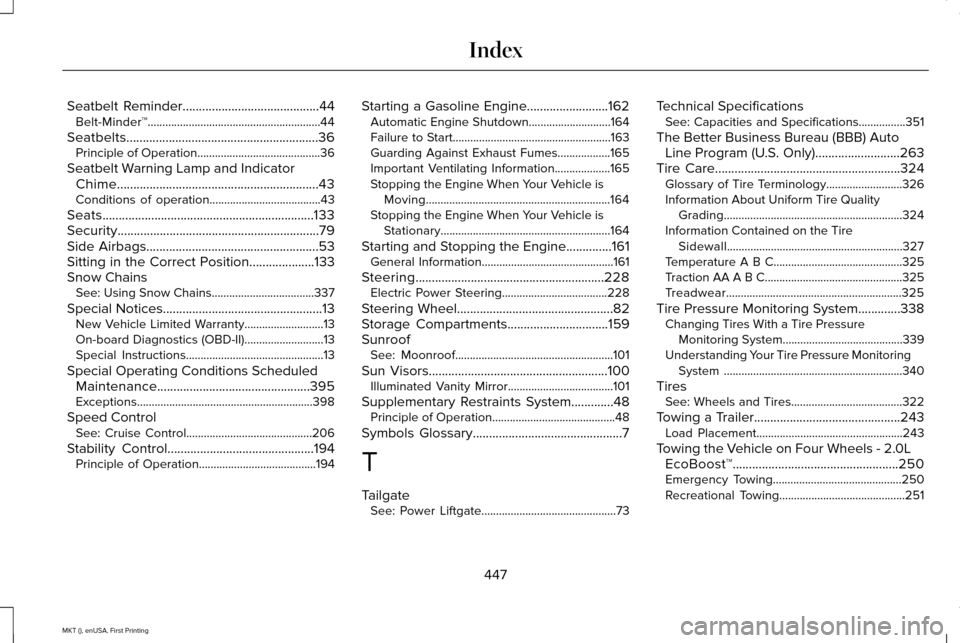2016 LINCOLN MKT OBD port
[x] Cancel search: OBD portPage 16 of 452

SPECIAL NOTICES
New Vehicle Limited Warranty
For a detailed description of what is covered
and what is not covered by your vehicle
’s
New Vehicle Limited Warranty, refer to the
Warranty Manual that is provided to you
along with your Owner’ s Manual.
Special Instructions
For your added safety, your vehicle is fitted
with sophisticated electronic controls. WARNINGS
You risk death or serious injury to
yourself and others if you do not follow
the instruction highlighted by the warning
symbol. Failure to follow the specific
warnings and instructions could result in
personal injury. Front seat mounted rear-facing child
or infant seats should NEVER be
placed in front of an active passenger airbag. On-board Diagnostics (OBD-II)
Your vehicle
’s On-board Diagnostics (OBD-II)
system has a data port for diagnostics, repair
and reprogramming services with diagnostic
scan tools. Installing a non-Ford-approved
aftermarket OBD plug-in device that uses
the port during normal driving, for example
remote insurance company monitoring,
remote vehicle diagnostics, telematics or
engine reprogramming, may cause
interference or damage to vehicle systems.
We do not recommend or endorse the use
of any non-Ford-approved aftermarket OBD
plug-in devices. The vehicle Warranty may
not cover damage caused by any
non-Ford-approved aftermarket OBD plug-in
device. MOBILE COMMUNICATIONS
EQUIPMENT
Using mobile communications equipment is
becoming increasingly important in the
conduct of business and personal affairs.
However, you must not compromise your
own or others
’ safety when using such
equipment. Mobile communications can
enhance personal safety and security when
appropriately used, particularly in emergency
situations. Safety must be paramount when
using mobile communications equipment to
avoid negating these benefits. Mobile
communication equipment includes, but is
not limited to, cellular phones, pagers,
portable email devices, text messaging
devices and portable two-way radios.
13
MKT (), enUSA, First Printing Introduction
Page 178 of 452

You can correct these temporary
malfunctions by filling the fuel tank with good
quality fuel, properly closing the fuel fill inlet
or letting the electrical system dry out. After
three driving cycles without these or any
other temporary malfunctions present, the
service engine soon indicator should stay off
the next time you start the engine. A driving
cycle consists of a cold engine startup
followed by mixed city and highway driving.
No additional vehicle service is required.
If the service engine soon indicator remains
on, have your vehicle serviced at the first
available opportunity. Although some
malfunctions detected by the OBD-II may not
have symptoms that are apparent, continued
driving with the service engine soon indicator
on can result in increased emissions, lower
fuel economy, reduced engine and
transmission smoothness and lead to more
costly repairs.
Readiness for Inspection and
Maintenance (I/M) Testing
Some state and provincial and local
governments may have
Inspection/Maintenance (I/M) programs to
inspect the emission control equipment on
your vehicle. Failure to pass this inspection
could prevent you from getting a vehicle
registration. If the service engine soon indicator
is on or the bulb does not work,
your vehicle may need service.
See On-Board Diagnostics.
Your vehicle may not pass the I/M test if the
service engine soon indicator is on or not
working properly (bulb is burned out), or if
the OBD-II system has determined that some
of the emission control systems have not
been properly checked. In this case, the
vehicle is not ready for I/M testing. If the vehicle
’s engine or transmission has
just been serviced, or the battery has
recently run down or been replaced, the
OBD-II system may indicate that the vehicle
is not ready for I/M testing. To determine if
the vehicle is ready for I/M testing, turn the
ignition key to the on position for 15 seconds
without cranking the engine. If the service
engine soon indicator blinks eight times, it
means that the vehicle is not ready for I/M
testing; if the service engine soon indicator
stays on solid, it means that your vehicle is
ready for I/M testing.
The OBD-II system checks the emission
control system during normal driving. A
complete check may take several days.
If the vehicle is not ready for I/M testing, you
can perform the following driving cycle
consisting of mixed city and highway driving:
1. 15 minutes of steady driving on an expressway or highway followed by 20
minutes of stop-and-go driving with at
least four 30-second idle periods.
175
MKT (), enUSA, First Printing Fuel and Refueling
Page 450 of 452

Seatbelt Reminder..........................................44
Belt-Minder™...........................................................44
Seatbelts...........................................................36 Principle of Operation..........................................36
Seatbelt Warning Lamp and Indicator Chime..............................................................43
Conditions of operation......................................43
Seats.................................................................133
Security..............................................................79
Side Airbags.....................................................53
Sitting in the Correct Position
....................133
Snow Chains See: Using Snow Chains...................................337
Special Notices
.................................................13
New Vehicle Limited Warranty...........................13
On-board Diagnostics (OBD-II)...........................13
Special Instructions...............................................13
Special Operating Conditions Scheduled Maintenance...............................................395
Exceptions............................................................398
Speed Control See: Cruise Control...........................................206
Stability Control
.............................................194
Principle of Operation........................................194 Starting a Gasoline Engine.........................162
Automatic Engine Shutdown............................164
Failure to Start......................................................163
Guarding Against Exhaust Fumes..................165
Important Ventilating Information...................165
Stopping the Engine When Your Vehicle is
Moving...............................................................164
Stopping the Engine When Your Vehicle is Stationary..........................................................164
Starting and Stopping the Engine..............161 General Information.............................................161
Steering..........................................................228 Electric Power Steering....................................
228
Steering Wheel
................................................82
Storage Compartments...............................159
Sunroof See: Moonroof......................................................101
Sun Visors.......................................................100 Illuminated Vanity Mirror....................................101
Supplementary Restraints System.............48 Principle of Operation..........................................48
Symbols Glossary
..............................................7
T
Tailgate See: Power Liftgate..............................................73 Technical Specifications
See: Capacities and Specifications................351
The Better Business Bureau (BBB) Auto Line Program (U.S. Only)..........................263
Tire Care
.........................................................324
Glossary of Tire Terminology..........................326
Information About Uniform Tire Quality
Grading.............................................................324
Information Contained on the Tire Sidewall............................................................327
Temperature A B C............................................325
Traction AA A B C...............................................325
Treadwear............................................................325
Tire Pressure Monitoring System.............338 Changing Tires With a Tire Pressure
Monitoring System.........................................339
Understanding Your Tire Pressure Monitoring System .............................................................340
Tires See: Wheels and Tires......................................
322
Towing a Trailer.............................................243 Load Placement..................................................243
Towing the Vehicle on Four Wheels - 2.0L EcoBoost™...................................................250
Emergency Towing............................................250
Recreational Towing...........................................251
447
MKT (), enUSA, First Printing Index